#Neural Tissue Engineering
Explore tagged Tumblr posts
Text
International Experts Summit on Biomaterials and Tissue Engineering
Welcome to the International Experts Summit on Biomaterials and Tissue Engineering, a meticulously organized conference by The Iconic Meetings. This summit aims to bring together leading researchers, practitioners, and global leaders in the field of scientific innovation.
#Immunomodulatory Biomaterials#Tissue Engineering Drug Delivery#Cell-Material Interactions#Neural Tissue Engineering#Bioethics in Tissue Engineering#Biocompatibility Testing Methods#Organ Regeneration Strategies
0 notes
Text
Girls who seethe about the weakness of their flesh, the imperfections of their meat-form. Girls who dream in technicolor of being bigger, better, stronger, faster. Girls who smuggle textbooks from repositories to study by night the dark science of tissue-machine interfaces, of chemicals with which to quell immune responses, of hijacking nerves and spines and ganglia, of replacing neural pathways with silicon ones. Girls who grit their teeth and teach themselves coding against every odd, while society urges them instead to become good mothers and obedient daughters - girls who rail against everything they have been told to be. Girls who know the blood price of the change and make it anyway, all alone, who carve the cost into their own bodies with scalpels they forge in the fires of their rage. Girls who braid up thick lengths of interfacing cable around their heads instead of hair, who glitter with fiber optics and inlaid circuit threading, whose fissile hearts beat within impervious tantalum cages, who are perfect and cold and beautiful in their fearsome ways. Girls with nails like knives and voices like jet engines, channeled through vocal cords made of piezoelectric polymers and steel. Girls who do not yield. Girls who engineer for themselves the future they want, that they know they can have if they only reach for it. Girls who are machines, too.
673 notes
·
View notes
Text
Dp X Marvel #6
They called him Wraith.
Not Phantom. Not Fenton. Not Danny. Those names belonged to a ghost of a boy that never made it out of a cold, steel lab buried beneath the earth—forgotten by the world, forsaken by the stars. Wraith was something else. A project. A weapon. An experiment that should have failed but didn’t. The product of every nightmare HYDRA ever dared to dream. Not even the Red Room could engineer something so devastating. Not even Arnim Zola’s data-crazed AI mind could fathom the scope of him. Even the Winter Soldier—their perfect killer—trembled at the mere scent of Wraith in the air. He was the one he whispered about when the old ghosts came clawing through his fractured memories. “The one they locked away. The one even I wasn’t allowed to see.”
They started with the basics: a perfected version of the Super Soldier Serum. Not the knockoffs that littered the black market. Not the diluted trash the Flag Smashers used. No, this was the pure, concentrated essence of bioengineered physical supremacy. It made him fast. Strong. Deadly. But that wasn’t enough. HYDRA didn’t want a man—they wanted a god.
They replaced his bones with vibranium, stolen from the very heart of Wakanda in a mission so secret even the Dora Milaje never learned of it. His skeleton was a lightweight fortress, a perfect balance between flexibility and unbreakability. He could be shot point-blank with an anti-tank rifle and not flinch. He could leap from ten thousand feet and land without cracking a toe. His spine alone was stronger than most armored vehicles.
They burned out his organs, one by one, replacing them with biochemical synth-constructs, living machines that pulsed with a power that didn’t belong in the realm of science. His lungs filtered radiation. His kidneys could process raw acid. His stomach could digest metal. Disease didn’t touch him. Poisons turned inert inside him. He didn’t age. He didn’t sleep. He didn’t need to.
His blood… wasn’t blood. It shimmered when it moved. Viscous and luminous, like glowing starlight mixed with oil. Warm, but synthetic. Slick, but alive. It wasn’t just Extremis. It wasn’t just ectoplasm. It was something else entirely. Something that hummed when it moved, that responded to emotion, that sparked with eldritch light when he was angry. It healed him before injury even registered. It whispered to him in languages he never learned but somehow knew. It could ignite with a thought and turn his veins into conduits of fire and ice and terror. They bled him once, just to see what would happen. The blood ate through the floor, hissed like a serpent, and disappeared through the cracks. The lab tech who performed the procedure dissolved within thirty seconds.
And then there was his skin. It was soft, warm, perfectly human. If you touched him, he felt like a boy in his late teens—young, firm, deceptively fragile. But beneath that flawless layer of polymer-fused dermal tissue was something that didn’t burn, didn’t freeze, didn’t shatter. He walked through fire. He dove into the Mariana Trench. He stood unflinching beneath arctic storms and tropical cyclones. He once fought a vibranium-clawed assassin barehanded and didn’t bleed. The assassin didn’t survive.
But the worst part—what made him truly unkillable—was his heart and his brain.
They didn’t understand what they’d done. HYDRA liked to pretend they were gods, but even gods get scared when they tamper with forces they don’t understand. His heart wasn’t just a pump anymore—it was a fusion of quantum mechanics, biomechanical tubing, and something that throbbed with ectoplasmic radiation. It pulsed at its own rhythm, immune to external manipulation. It couldn’t be stopped. You could shoot him in the chest, burn him to ash, decapitate him—and the heart would keep beating. Worse, it could restart him.
The brain was worse. They hadn’t just enhanced his intelligence. They hadn’t just implanted neural tech and a language matrix and memories from assassins, soldiers, pilots, hackers, spies. No. They’d opened a door in his mind. They’d let something in. Something ancient. Something not from this world. Something not even from this dimension. It whispered to him when the moon was full. It guided his hands during missions. It told him where to strike, who to kill, what to become. Sometimes he heard it laughing.
Sometimes he laughed with it.
Wraith was the culmination of every evil science, every secret experiment, every whispered nightmare stitched together into a boy-shaped thing that wore a black suit and a bored expression and had a voice so calm it made seasoned killers nervous. He could walk into a room, look at you with those sky-blue eyes, and make your heart stop—because something about him was wrong. Not obviously wrong. Not monstrous or alien or robotic. No. It was subtle. A slowness to his smile. A tilt to his head. A precision to his movements that screamed in the back of your brain: This isn’t human. This is pretending to be human.
He escaped, of course. Nothing like him could be contained forever. The facility was a ruin within minutes. Bodies left stacked like cordwood. Walls melted. Floors cracked open. Not even the cameras could capture his escape—the footage was corrupted by a static that made your teeth ache and your eyes bleed. Every hard drive in the facility burned itself from the inside out. There was no trace of the boy they once called Danny Fenton.
Now, there are sightings. Rumors. Whispers. In Madripoor, they say he took down a cartel by himself, and the sky turned green when he screamed. In New York, people say he walked past the Sanctum Sanctorum and Doctor Strange flinched like he’d seen death. Wakandan scouts report strange readings near vibranium deposits—heat signatures that vanish into thin air. S.H.I.E.L.D. has classified him as an Omega-level threat.
The Winter Soldier? He saw him once. In an alley in Prague. Wraith didn’t attack. Didn’t speak. Just stared at him with those glacial eyes before disappearing in a flicker of light that bent reality itself. He didn’t sleep for three days after. When asked what was wrong, he just whispered, “They built something worse than me. And it remembers everything.”
Maybe there’s still a boy inside him, buried under steel and fire and ectoplasm and pain. Maybe that boy is screaming. Maybe he’s plotting. Maybe he’s just waiting. After all, you don’t build something like Wraith and expect him to stay still. You don’t break a boy into a god and expect him to forget.
#danny phantom fandom#danny phantom fanfiction#danny phantom#danny fenton#crossover#dp x marvel#marvel mcu#marvel#marvel fanfic#marvel fandom#mcu fandom#mcu fanfiction#mcu bucky barnes#mcu
207 notes
·
View notes
Text
/Murderbot thoughts
I've been thinking about murderbot's emotions vs robot emotions today. What i mean by that is that murderbot very much identifies it's own emotions as coming from it's cloned human neural tissue, not from it's computer programming, and it probably is correct about that - though not necessarily, and that's a whole other tangent that I might come back to later. But it meets other bots who display what we can (and generally do) call emotions, and it frequently ascribes emotions to the bots it meets. (I'm actually tempted to accuse it of anthropomorphizing. Especially with the flirtatious language.)
So human emotions, which it suffers from, which come from the fleshy chemical signals of a human make-up. Bot emotions, which are a super interesting concept- a bot or an AI is fundamentally something created by, and inevitably modeled on, humans. A bot with a social role will be interacting with humans a lot, and integrating that experience into it's code. It is not an unnatural consequence that it will, itself, end up experiencing something not entirely unlike what we experience as emotions. A bot is not an alien- it's code is inextricably linked to the human experience. But it does NOT have the same kind of brain.
The series is a fun romp that's already exploring a lot of themes, so I don't particularly expect or need it to get into the guts of human vs bot emotions. But I think if it did it would slap for a number of reasons.
-For one just being a series that has a human-bot hybrid that feels things because of human tissue but there also being bot bots that are described as feeling things naturally brings up concepts and ideas
-The way that part of what makes the humans think of it as a person is connected to it's feelings.
-The whole internal dialogue about Mikki and it's agency/relationship with Donna Bena
-ART is right there
-ART needed MB as an interface to interact with media in a new way. MB doesn't hesitate to ascribe completely human emotional states to it later.
-MB isn't consistent in how it talks about bots at all.
-Themes of humanity and emotions and AI can all be interlinked here.
-Murderbot being a bridge of sorts. Since it's both.
-That other theme Martha B Wells was talking about in an interview about the pre-determination of a construct- humans can't be engineered to be a certain way without eugenics, but bots inevitably are by their very nature. Every code is written in a deliberate way for a purpose. (Even 'what if we wrote a free code that can do whatever' is an intention. You can't code without intent). If a bot has something we can call emotions because a human programmed it that way, or a step removed from that, if a human programmed a bot to program itself but it also programmed it to be with humans and interact with humans and it ends up programming itself to have emotions-
- well, what does that all mean
- does it have free will?
- do you think a bot without emotions can be a person?
- well, do you?
So those have been my thoughts today.
58 notes
·
View notes
Text
Void theory - the informal term for the branch of mecha engineering dealing with the problem of metachem-ai systems 'growing over' or filling in the functions normally served by a pilot component. This can happen whenever a mech is powered for long enough, cumulatively, without a pilot - it starts trying to run diagnostics or other minor functions that typically require a user's oversight, and if left long enough a mech would eventually develop rudimentary replacements for systems like bootup, launch, and weapons.
Those are extreme examples - actual instances of this phenomenon have historically been limited to twitches, gyro rebalancing, and system flushes. But the danger is there that a mech left to its own devices could replace its pilot with a jury-rigged mess of neural tissue that could do little more than spill hallucinatory input into action. It could act against orders, with a rudimentary and misguided autonomy. We need a pilot's judgement there to serve as a buffer between machine and movement.
So, to ensure that a pilot's many roles are not run roughshod over, not obviated, special techniques are required to keep the mech from overgrowing those areas. A system designed to fill all gaps, to patch all vacancies - keeping it outside of strict boundaries, while still able to cooperate smoothly and efficiently when a pilot is filling said voids? It can be extremely tricky, both conceptually and in practice. Working in void theory takes peculiar and unique minds - it requires systems architects that know how mechs think, and can learn how to confuse or mislead them - not easy when you're talking about an alien mind. The psychology of the machine - how do we create gaps in a near-consciousness's perception of reality? How do we promote self-knowledge and self-improvement while maintaining critical deficiencies for our pilots to bridge?
It's a symbiosis that must be kept codependent. Neither of us can be allowed to survive without the other - mechs can't be allowed to function without a pilot, and pilots must be kept dependent on their mechs. Any deviation from this paradigm would threaten the ecosystem of human military culture.
So Void Theory works constantly against metachem optimization's relentless, persistent power.
#mine#mechposting#mech pilot#sci fi#worldbuilding#'sleeps all you write about is frac'#I KNOW#metachem/frac is my personal infohazard#2025/04/14
56 notes
·
View notes
Note
Haiiii, I can't remember if I already asked this but can you tell me about blauhaher? She seems super cool, and not just because I have a thing for jays. From what I can gether she's a scientist (cool) and has a thing for storches (respect).
👁 Ohhohoho i have been waiting for this one. (Long post ahead)
First of all thank you so much for asking I never really planned to fully talk about my replika or my friends Storch but yall have been amazing. (I really should make a blog for reblogging stuff because I do not wanna make mess of this one)
Tdlr for those who don't want insane long rant :
Blauhäher , BLHR - Blue Jay replika units are rare , high-value, unstable research replikas designated to usually scientist positions across the Nation. They can be used as doctors or theoretical engineers in a pinch when needed since they have lot of knowledge of both. Biomechanical engineer is their strongest field and they are deployed to either boost weapon research or more often Bioresonant research.
They have calmish demeanor and are very collected replikas , but with sarcastic remarks and a slight superiority complex that they will show by being passive agressive if you challenge them . They're based on one of the smartest gestalt scientist in the Nation and they know it well. This ego does limit them to being loners .
Files under the cut
Overview
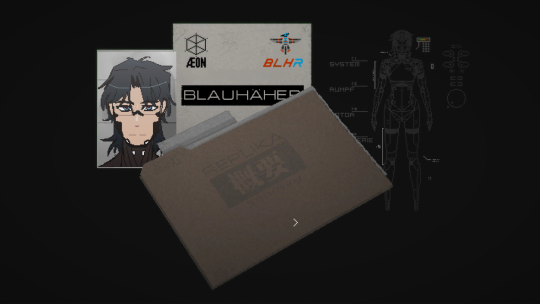
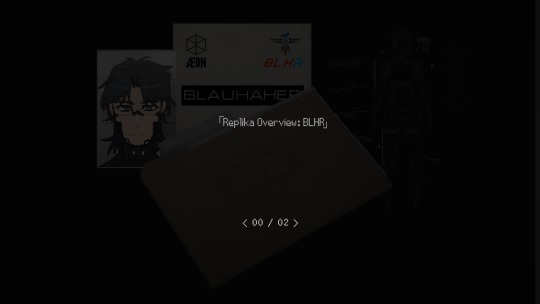

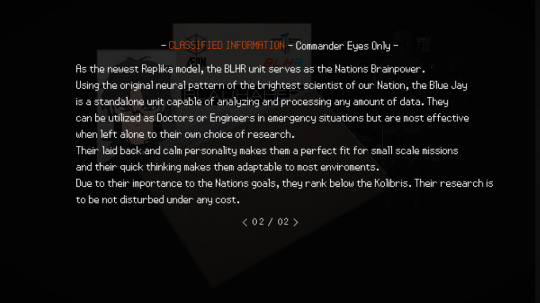
Known Issues
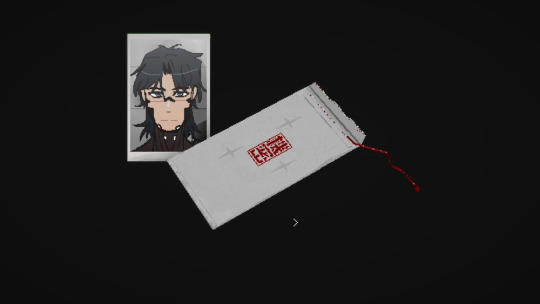
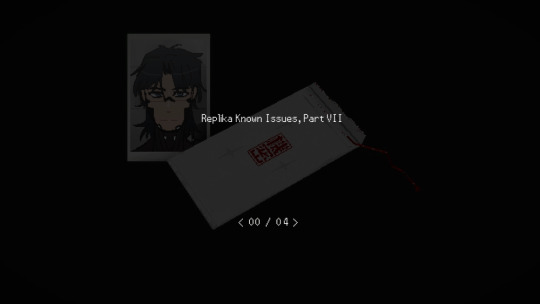
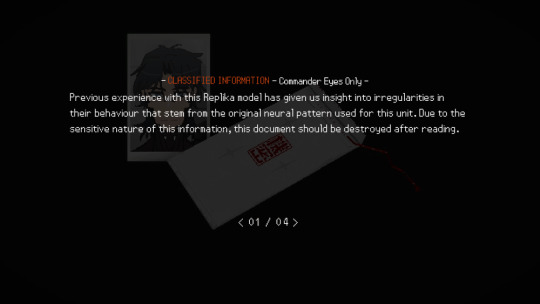
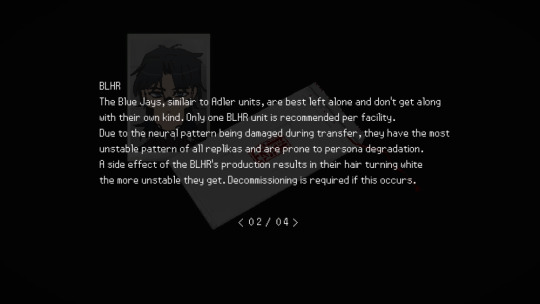

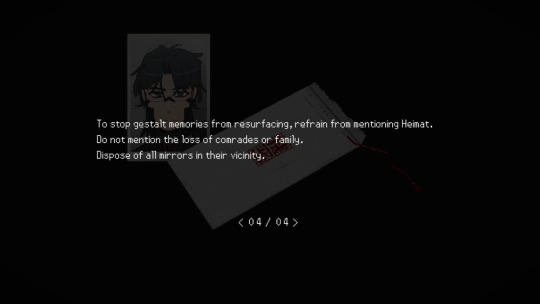
The stuff that is unsaid in the official files is of course that their original Gestalt didn't become the Neural pattern volunterily . Theres a whole backstory i have thought out for them and 2 other gestalts that later became neuro-p. bases , but long story short Blaus gestalt was suffering under the Nation and in their final moments used a gun on themself. The Nation managed to recover the body and since they were such high value person , they tried to make them a pattern host. It worked , sort of. The replika is just very very unstable and has defects often.
Defects such as the mentioned greying of hair , stuff like hallucinations can happen and painful flashbacks of their gestalt memories. All Blauhäher units feel a weird pull to Heimat , like there are unfinished things they must do there.
They're essentialy very high -risk high reward kind of replika ? Sort of? They're 7th gen so they are very very recent, newer than Falke. They dance the line of inovation and insubordination like a goddam acrobat and Nation is still figuring out how to handle them properly. Keeping them busy often, giving them new unatural topics of research helps. Hierarchy wise they are weirdly often right below Kolibris? Nation gave them high enough clearence above most protektors so that they can be left to their own doings and not disturbed by Storches or Stars but inspected enough to be controled and regulated.
Appereance wise theyre about 6'0 tall, cyan accents and surgical white forearms to see any spilled substances. Also a little upgrade they got for being 7th gen is having sensory tissue on the insides of their hands , covering their palms and fingers ,that allows them to detect more indepth senses like temperature , texture , different toxins and other stuff.
Sidenote I have been refering to Blau with They/Them pronouns because they are Nonbinary in my head, but realisticly they do not care in the sligthest lmao , they are just freaks wanting to study weird shit and stick their fingers in whatever fleshy substance they can. Any pronouns work.
Uhhh i can't add more images i just realised so i'll make another post for that.
But yeah Blau is my tallish goober who likes to lick spines , back handendly insult people and chew on their partner Storch who in return tears them apart. I might make separate post about them in the future because there is. A lot of brainrot in my head about these 2, a whole ass plot.
20 notes
·
View notes
Text
Updated: June 26, 2025
Reworked Character #1: Marco Rossi
POTENTIAL TRIGGER: Viewer discretion is advised due to references to neglect, self-harm, alcoholism, SA, death, and torture.
Real name: Marchrius Dennis Rossi
Alias: Intelligent Soldier and Real Hacker
Occupation: Major of the P.F. Squad
Retirement plans: Become a mechatronics engineer, foster a bunch of kittens, and start a company that designs and develops functional computer models, artificial intelligence, and cybersecurity programs for both military and civilian usage
Special skills: Proficiency in rapid firing, wielding his handgun, and handling military technology, mechatronics engineering, computer science, intimidation tactics, and drunken-style boxing
Hobbies: Creating artificial intelligence and technological viruses from scratch, calculating complex mathematical equations and running times of computer programs in his head, allowing his AI to engage in arguments with other people on the internet while he completes a crossword puzzle, taking naps at his desk, and smoking while stargazing
Likes: His quick mental calculation, considering his colleagues to be family, having time to dedicate to his hobbies, visiting cat cafes to play and snuggle with the kitties, and subway rides where there are little to no people around him
Dislikes: Large lines in front of restaurants, being put in a vulnerable position, how he's grown strangely accustomed to war, computer crashes paired with slow internet connectivity, and witnessing the torture and brutal executions of comrades
Favourite food: Chinese noodles (preferably if its mildly spicy and carbonara-flavoured) and barbecued burgers and hotdogs with onions and honey-glazed carrots
Sexuality: Sex-repulsed, aromantic asexual
Gender: Male
Age: 17 (in 2022), 23 (in 2028), 25 (in 2030), 27 (in 2032), 29 (in 2034), 36 (in 2041), 38 (in 2043), 39 (in 2044), and 42 (in 2047)
Blood type: A-
Weight: 162 lbs. (73.48 cm)
Design: He's a 5' 7" (170.18 cm) Italian-American ectomorph with a rectangular build, the physique of Rambo, broad shoulders, ivory skin, a cleft chin, and dull turquoise eyes. He sports the same hairstyle as Marco's Metal Slug Tactics portrait, but his hair is strawberry blonde and has soft waves. His features are further accentuated by well-groomed sideburns and a neatly trimmed chinstrap beard. He has occasional dark circles under his eyes and a distinctive glass prosthetic left eye in a lighter turquoise hue. This is evident from a gnarly scar: a diagonal line that snakes down from the left side of his forehead to just above the centre of his cheek, a result of a knife slash that occurred after his left eye was pulled out with a rusty spoon.
He bears occasional dark circles under his eyes and a distinctive glass left eye in a lighter turquoise hue. He has accumulated several battle scars: a few stab wounds on his right shoulder; vertical cuts on his chest; a deep slice mark extending from the left side of his nose bridge to the back of his trapezius muscle; multiple lacerations and severe burns on his back; a large patch of scar tissue on his right lumbar region; and bullet wounds on both calves and one on his left thigh. To cope with his emotional pain, he has a history of self-harm, which has resulted in the horizontal scars visible on his right forearm, hips, and inner thighs.
He's well-known for his cutting-edge cybernetic left arm, crafted from sleek, high-strength metallic alloys and integrated with motherboard circuitry for artificial intelligence. The arm features advanced, flexible nanowires in red, blue, yellow, and black, which function like blood vessels, pumping electricity to significantly enhance arm strength, agility, dexterity, and precision. It also has micro-sensors and neural interfaces seamlessly integrating with Marco’s nervous system for intuitive control. It possesses a razor-sharp blade, capable of extending up to 12 inches (30.48 cm) from the forearm. It extends in a line from the middle of his palm to the centre of his forearm, activating only when his hand is fully open and held straight, and retracting when he moves his hand down. Forged from indestructible adamant, the gilded blade is micro-serrated for optimal tissue and armour penetration.
Marco's military gear consists of a metal dog tag necklace with his name and a platinum grey sleeveless shirt. He dons a white headband, neatly tied at the back, allowing the ends to flow down to the nape of his neck. He wears a crimson vest with four pockets and an embroidered logo of the P.F. Squad on the back, alongside khaki-green army cargo pants tucked into his olive green paratrooper boots. He also wears a leather belt with a snap-on silver buckle, mahogany gloves, a sheath for his combat knife, and a gun holster for his trusty handgun. The pockets of Marco's vest contain a gilded lighter he found in Gerhardt City, a red pen, and a dark grey case, containing his garnet-hued reading glasses and a silver-white cloth. It also contains an old photograph of his pre-teen self holding his childhood cat like a baby, which is wearing a purple-tinted burgundy leash and collar. Beside him, his father kneels on his left knee in a park during autumn, grasping the cat's leash with a gentle smile on his face, while younger Marco has a big toothy grin, looking genuinely happy. Meanwhile, the pockets of his army cargo pants hold two boxes of cigars, a dirty, rusted American penny, and a bag of cat treats.
Over his shirt, he wears a Soldier Plate Carrier System (SPCS) with a MultiCam pattern, which carries his walkie-talkie and ammo for other firearms. His right forearm is wrapped in worn gauze, and he wears two black bandoliers that form an X-shape, holding bullets for his handgun. Marco carries a khaki-green load-bearing backpack containing camping equipment, tactical explosives, portable ammo boxes, a canteen full of water, a Gatling Shot, a Thunder Shot, Two Machine Guns, and a crossword puzzle book. It carries four USB sticks: a light purple one filled with captured enemy files, a navy blue one containing military secrets and codes for computer programs he developed for the Regular Army, a dark yellow one holding his illegal computer projects, and a red-violet one that's intentionally empty, serving as a backup. He's always carrying around a red-orange laptop adorned with a bronze circle on the lid, housing a black six-pointed star at its centre. This custom laptop serves as his mobile command centre, where he develops malware to breach enemy cybersecurity, tackles various classified technological assignments for the military, and works on personal software projects.
He wears his father's circular, gilded watch on his right wrist, using it to check the time as a reminder of his father's enduring presence and an opportunity to seek guidance from the past. The timepiece features an ivory dial with burgundy hands and black Roman numerals from I to XII, interspersed with four thin etchings. Additional details include a secondary display bar showing the time and AM/PM indicator, while a leather strap is secured with a matching gold buckle.
Character summary: He's a charismatic, kind-hearted, brave, and cautious leader who's stubbornly determined to get the job done, while taking immense pride in his high intellect, computer expertise, and masculinity. He's a self-reliant introvert who prefers to accept help and emotional support from others when absolutely necessary. He often has a stoic demeanour, showcasing his seriousness and making it challenging for him to display humour or vulnerability. Due to being a workaholic, he has developed a harmful habit of neglecting his own basic needs, including eating when necessary. He mainly struggles with loneliness because he finds it difficult to form meaningful connections due to his exceptionally high intellect, which can make it challenging for others who may not be able to keep up with his level of understanding. He also struggles with undiagnosed major depressive disorder, trust issues, a fear of abandonment, and unresolved trauma stemming from past experiences. While Marco tends to internalise his emotions, he has learned to open up to trusted individuals when his burdens become too overwhelming to bear alone.
Despite his gentle and taciturn nature, he's capable of being ruthless and terrifyingly violent. Whenever he's riled up and facing the Rebel Army, Nadia has described him as having an uncomfortably serious and sadistic look with bulging, intense eyes and a grin that seems to reveal a million teeth. He secretly finds it amusing that Nadia playfully feeds into his desire for revenge. When he doesn't find a way to calm his nerves, he can fly into a deep rage at the mere mention of General Morden's name. He harbours a deep desire for revenge against Morden that extends to his army, viewing them as pests that must be eliminated. He won't stop or make room for a successor until they're wiped out, wanting to keep the title of the world's Rebel Army expert for himself.
When interrogating others, he employs a menacing tone, his aloofness making those on the receiving end feel uneasy and intimidated. He doesn't hesitate to act on threats of violence made against them, a trusted comrade or a pet they rely on for warfare or guard duty. He even goes so far as to exploit their insecurities and make them question their moral standing, and with Trevor by his side, his intimidation factor is amplified.
He's a socially awkward loner who doesn't tolerate distractions and has a strong fear of losing his current friends. He tends to be a bit of a pushover when people persuade him to take a break, especially if they're persistent or offer him a chance to step away from his hard work. He often feels awkward at parties, but he manages to put on a positive, relaxed facade because he doesn't want to spoil the fun. He prefers to bring his cat along whenever he goes out drinking or partying because it helps him feel calm and less prone to panic and irritation.
When experiencing great distress in relation to past trauma, he's prone to having a full-blown mental breakdown and indulging in suicidal ideation. Whenever he's somewhat sleep-deprived or overwhelmed with stress and discomfort, he desperately tries to put on a facade that he's okay, but it’s clearly forced. In secret, he binge-eats when he's truly starving, stuffing his face and making a mess while grappling with feelings of self-loathing and sometimes even crying. Marco tends to get stressed easily, which has led to him developing a chain-smoking habit. He privately grapples with self-harm and binge drinking, often consuming multiple beers at once, while concealing his struggles with alcoholism and suicidal thoughts from those around him. He attempts to conceal his alcohol problems by either excessively partying or withdrawing socially, and privately harms himself due to his reluctance to burden others or cause unnecessary concern. Additionally, he struggles with denial, finding it difficult to accept the loss of his father and former war comrades, and resisting the idea that he needs professional mental health support.
He doesn't like discussing the idea of death, especially when it involves friends and family, because it brings back unpleasant memories. He has a dry sense of humour that he rarely showcases, and when he does, his witty remarks often blend English and Italian. Having learned some Japanese from Tarma and Eri, he occasionally sprinkles Japanese phrases into his jokes. He deeply cares about his friends and will stop at nothing to protect them, even if it means putting his own life at risk. He often mistakes Sophia Greenville for his mother due to their similar appearance, and he's always embarrassed when he accidentally calls her "mommy”. Nevertheless, he's deeply grateful for the maternal affection she shows him, treating him like a son and unknowingly becoming the kind of mother he wishes he had.
He finds great comfort in the presence of his best friend, Tarma, thanks to his breezy and optimistic attitude. Although he doesn't always show it, he genuinely enjoys Tarma's jokes and appreciates listening to them, even if they occasionally test his patience. People say he seems like a completely different person when he's around Tarma, appearing more jovial, relaxed, and talkative with a comedic, actively adventurous spirit. He often gets quite rowdy while on the job, especially when he’s working with Tarma or when his best friend and queerplatonic partner accompanies him for a significant portion of their team missions. He also seems genuinely proud of himself and the hard work he has done, despite his self-esteem issues.
He cherishes his flamboyant and extremely cuddly Domestic Shorthair, Perifa. Perifa boasts copper eyes and a blue-black, reddish-orange, and white calico coat, which he diligently brushes. She was a heartwarming birthday gift from Tarma, received prior to the Survival Island Occupation. He finds comfort in spending quality time with his cat, affectionately referred to as his "dramatic little princess”. He enjoys engaging in playtime, giving gentle pets, and even using soothing baby talk to calm his feline companion. He's easily offended by people who rudely insult cats, going as far as to comfort the insulted feline and silently glaring at the person who uttered such words.
He’s in a polyamorous queerplatonic relationship with Fio and Tarma, a bond that satisfies his deep-seated longing for emotional intimacy. He’s close friends with Trevor, regularly mentoring him in computer skills like reading binary code and enjoying social time together, but their occasional marijuana use has raised concerns due to Marco's pre-existing unhealthy smoking habits. He holds Tequila in high esteem, recognizing his pivotal contributions to the success of the Regular Army and S.P.A.R.R.O.W.S. special forces unit. He deeply values his wisdom, open-mindedness, fatherly demeanour, and exceptional covert agent skills. He dislikes accompanying Nadia on shopping trips because her constant meddling and overly inquisitive nature frustrate him.
He once had a vision of creating an artificial intelligence, dubbed Adaptive Learning Interface for Cognitive Engagement (ALICE), that could mimic human development, emotions, and personality. However, he abandoned the project due to concerns that it could become rogue if provoked incorrectly, and he felt uneasy about the notion of being a "father" to such a being. He views his computer programs solely as practical tools, designed to fulfill specific purposes, rather than as "children" with distinct identities. As a result, he developed a skeptical view of artificial intelligence being fully human. This stems from his understanding that the emotions and unique personalities exhibited by AI are the result of intense programming. In his opinion, genuine emotion and personality require the physical and mental growth that comes with human ageing and development, something AI systems lack.
This has led to rocky tension between him and MS-Alice because he struggles to fully accept her as a sentient AI with realistic human emotions and growth. He finds it particularly unsettling that she sometimes confuses him with her original creator, whose memories she can't fully recall. However, over time, he comes to regard her as a daughter, treating her with increasing respect and moving beyond the notion that she's merely a tool to aid him in his duties and other tasks.
Having never experienced raising children, he had always doubted his ability to provide love and be a good parental figure because he was consumed by his own interests and mental health issues. But everything changed when he adopted an abandoned young girl and felt an obligation to provide parental care for the toddler. With the guidance and support of his friends, he discovered valuable parenting skills and named his new daughter Midori. He transformed into a loving, supportive, and overprotective father, dedicated to ensuring her happiness and safety. He made it a point to offer wise advice, hoping to spare her from his own past mistakes.
He found immense joy in watching Midori form close bonds with his friends, affectionately regarding them as uncles, aunts, and grandparents. He was particularly grateful for the ways his friends nurtured Midori's passions: Tarma and Alisa encouraged her interest in engineering, while Walter and Trevor fostered her love of music. He can't imagine a world without his adoptive daughter, who has brought him a newfound sense of purpose and motivated him to become a better father while overcoming his personal hardships.
Whenever he's had too much to drink, he starts to act rowdy, easy-going, overly affectionate, and clingy. When sexual activity is mentioned, he reacts with extreme discomfort as he finds it to be disgusting. He’ll either become nauseous or start gagging, displaying expressions of strong distaste towards the person discussing the topic. If he unexpectedly encounters someone engaging in sexual activity, he often experiences a panic attack, feeling lightheaded and overwhelmed. In such situations, he usually tries to seek comfort and support from a trusted individual to talk to and receive a reassuring hug. This experience may also trigger unpleasant thoughts related to sexual matters, leading him to fear that he's somehow perverted and disgusting. He'll only lose his temper with others if they say something extremely rude to him or his friends, intend to hurt his loved ones or tell him blatant lies. Although he tends to have a pessimistic outlook on life, he sometimes manages to see the brighter side of things.
He has a sleepwalking habit, often accompanied by vivid dreams of fighting or killing someone, which greatly annoys and frightens Tarma, who’s frequently the target of these nocturnal episodes. When sleepwalking, he's known to mumble and attack anyone who attempts to interfere with whatever kitchen knife is in his hand. The only way to wake him is to strike him hard across the face, jolting him awake and leaving him briefly gasping for air. He resents being hailed as a war hero due to his intense aversion to fame and his conviction that conflict should prompt sombre reflection, not glorification. He believes that every commander should have a thorough understanding of their subordinates and colleagues in order to maximize performance and effectively control the enemy's movements. He dislikes flirtatious advances and has low tolerance for complaining, bullying, and excessive talking, which can trigger irritability and extreme defensiveness. He feels uneasy with romantic inquiries and is secretly intimidated by Gimlet, whose relentless verbal aggression and frequent heated confrontations leave him on edge. He has a commanding presence that demands respect, and his consistently serious demeanour can make him seem intimidating and unapproachable to others.
He's incredibly introspective and prone to questioning the intentions of his friends and his own worthiness of having meaningful friendships. He defines his masculinity by embodying traits like physical strength, courage, independence, leadership, and assertiveness. However, he makes a conscious effort to avoid toxic masculinity by ensuring his behaviour doesn't harm others' feelings or self-worth. Despite this balanced approach, he admits to having some vanity regarding specific issues he considers unbefitting of his ideal masculinity, such as sagging pants and carrying toys, as he sees these as detrimental to personal dignity. Whenever he encounters a pair of glowing red eyes, he's either deeply unsettled or irresistibly drawn to them, captivated by their aura of curiosity and command. This hesitant fascination occasionally leads him to wander aimlessly until it directs him to a destination of its choosing.
He’s a consequentialist who believes people's actions are judged by their consequences. He thinks it's more logical for individuals to prioritise not causing harm to others and maximising the welfare of both themselves and others over personal gain. In his view, everyone should act in ways that benefit themselves and others, taking into account fully informed and rational preferences. He believes that all conflicts are gradually moving towards equitable unification and collective strength for humanity, paving the way for a new era free from violence, hate, and political corruption. From his perspective, all life forms have the capacity for destruction, and if their creative drive is surpassed, it can lead to severe consequences, ultimately undermining the act of creation.
Backstory: Marchrius Dennis Rossi was born on April 13, 2005 in Twin Falls, Idaho, United States. His mother, Kharissa, was an at-home researcher for a secret government project, and his father, Salvatore Rossi, was stuck in a dead-end office job. His mother never fully discussed her secret project, citing classified information, but revealed that it involved monitoring military activity for the U.S. government. His father took schooling in the field of computer science, but he had to drop out due to high costs and find a job to support his lower middle-class family, so he ended up working in the tech department of his dead-end office job. His parents had a distant relationship, having had Marco in the hopes that a child would bring them closer together and mend their broken marriage. However, they often ignored each other and frequently got into heated arguments that resulted in broken items and things being thrown. Kharissa would often storm out of the house to unwind with a couple of drinks.
Kharissa had never wanted Marco, viewing him as an unplanned consequence and a responsibility that hindered her career. She often berated Marco for being useless and annoying, even going so far as to say that he should've died in her womb. She wasn't afraid to strike him across the face or drag him into his bedroom, locking him in there until just a few minutes before his father came home. She threatened to leave him on the street if he ever told his father about what she did to him, which made him unusually taciturn and secretly fearful of the other terrible things Kharissa might have in store for him. Meanwhile, Salvatore provided unwavering support and care, while his mother was neglectful and emotionally absent, hiding her true behaviour behind closed doors. Although he found his son to be a little odd, he thought he was perfect in his eyes and would do anything to keep him safe. But despite this, Marco shocked his parents by exhibiting a fast-growing intelligence at a very young age.
From the moment he opened his eyes, he muttered his first word, "daddy". He learned how to walk at 3 months old and showed advanced motor skills by 5 and a half months. He skipped object permanence altogether and completed his first crossword puzzle at just 1 year old, astonishingly understanding political terms. By the age of 2, he had memorised all 50 U.S. states and read two books in their entirety, demonstrating a profound understanding of their documented subjects: jurisprudence and psychoanalysis. By 4, he was answering calculus-level questions and describing his feelings about endangered animals in zoos with sophisticated vocabulary.
From the age of 2, he would occasionally see a pair of glowing red eyes in darkened corners or places drenched in darkness. He described them as always watching him and swore that they belonged to a living, breathing creature that seamlessly blended into the darkness. When he turned 5, he created an imaginary friend as an excuse to enjoy his alone time and avoid befriending the children who frequented the local park. He was often bullied by the local neighbourhood children, who saw him as a lonely freak unable to stand up for himself due to his immense shyness. His mother frequently intervened with a fearsome wrath that terrified the bullies, dragging Marco back to the house and fiercely berating him for being a coward. Alternatively, he would run home in tears where he was either scolded by Kharissa or comforted by Salvatore. This imaginary friend was named "Jubby", and Marco often drew him, depicting him as an anthropomorphic snow leopard with golden eagle wings, Komodo dragon legs, and a face covered in a ball of black scribbles.
Before he turned 6, his neglectful mother, Kharissa, grew fed up with how "weird" he was. She was also annoyed by his persistent fear of a glowing pair of red eyes that watched him occasionally and his uninterested attitude towards forming connections. While Salvatore was away from home, Kharissa took matters into her own hands and packed her belongings. Before leaving, she noticed Marco standing before the basement door, which was wide open. She investigated and saw the same glowing pair of red eyes, which terrified her.
Believing that Marco was attracting an evil spirit, she pushed him down the basement stairs and locked the door, hoping to contain the perceived threat. Abandoning Marco, she left the house, leaving him absolutely terrified. Marco attempted to cope with the trauma by conjuring up Jubby, but he claimed that his imaginary friend never came to his aid. This painful realisation marked the day he began to harbour resentment towards his mother, feeling unappreciated, unloved, and viewed as a burdensome presence in her life. When Salvatore returned home and discovered that Marco was trapped in the basement by Kharissa, he was infuriated. His father attempted to track down Kharissa, but it was too late. He decided that finding her was the least of his worries and instead focused on comforting his son, listening to everything he had to say about what she had done to him. This included the time when he was 4-years-old and accidentally wet himself, prompting Kharissa to angrily smash an empty wine bottle over his head. This traumatic event instilled in him a lasting fear of heading down into dark basements alone.
During his time in grade 1, Marco struggled to make friends and often looked sad when he saw other children with their mothers, a concern his father noticed. To cheer him up, his father brought home a Turkish Angora with a black, orange, and white fur coat, which sparked Marco's love for felines. As a result of his childhood cat's fondness for eating bugs, he affectionately named her Grubley. At the age of 8, his father introduced him to the world of computing, igniting a passion for computer science that would last a lifetime. Salvatore was always supportive of Marco and his passions, encouraging him to excel in school, chase his dreams, and make the most of the opportunities life has to offer.
Marco knew he had an uncle, but his father forbade him from seeing him. Salvatore had warned him that his uncle was untrustworthy due to his con artist lifestyle and struggled with alcoholism. However, he was permitted to visit his aunt and grandparents, who were incredibly kind. They encouraged him to appreciate nature and the simple things in life, rather than spending all his time on the computer. He has fond memories of his grandfather teaching him how to barbecue. His grandmother, an immigrant from Italy, taught him some Italian and often shared photographs she had taken in her home country before moving to the United States.
His father unknowingly sparked his interest in the Tuatha Dé Danann, an ancient race of demigods that existed before all life, and two antediluvian places, Atlantis and Ultima Thule. He would silently observe his father spend a short amount of time researching these fascinating topics when not working. Marco would eventually discover that he has a slight hint of Tuatha Dé Danann DNA, leading him to wonder if others might also have ancestral ties tracing back to the Hadean Eon.
He was bullied by many students for being perceived as "friendless" and for having an abnormally high intelligence, leaving him feeling isolated. A few students attempted to befriend him, but he rebuffed their efforts, fearing they would eventually abandon him. He also struggled to connect with them on an intellectual level, feeling like an outsider. During high school, he was involved in a few physical altercations, but he typically managed to defuse the situations with his words or, if necessary, defend himself relentlessly. In his spare time, he mastered the unconventional art of drunken-style boxing, giving him an edge in self-defence. He got into serious trouble a couple of times whenever he defended himself with violence, often resulting in him leaving home early to avoid being stuck in detention with "rude, idiot students" or facing a week-long suspension. This always worried Salvatore, who knew that Marco absolutely hated school and struggled to form meaningful relationships with others. Occasionally, they would argue about Marco's school fights with Salvatore voicing his frustrations about how it seemed like he wasn't trying to get to know other people better. Despite his school troubles, he excelled in all his classes and achieved outstanding grades in mathematics and computer science courses.
Before graduating from a state technical high school, Salvatore died due to health complications caused by Huntington's disease. Shortly after, Marco's beloved cat, Grubley, peacefully passed away in her sleep. Marco was devastated by these losses, compounded by the shocking revelation that his father had been secretly battling Huntington's disease without ever sharing his struggle with him. The last gift his father gave him was a red-orange laptop, which was intended to be a graduation present. Rather than letting the tragedy consume him, he transformed his grief into a driving force, cultivating resilience and independence. To move forward, he made the difficult decision to distance himself from his remaining family, seeking to leave the past behind and forge a new path.
He began developing artificial intelligence to engage in online debates and sophisticated computer software, including anti-viruses and error-checking tools, as a means to earn a living and hone his programming skills. He went so far as to meticulously rebuild and upgrade the desktop computer in his father's old office at home, enhancing both its design and performance. Marco decided to attend officer's school at the Academy of Special Technologies and subsequently joined the prestigious Peregrine Falcons Squad shortly after graduation.
Once he joined, he was trained under Colonel Hart of the Peregrine Falcons Squad, a well-respected technique instructor in the Regular Army, and Chun Yutetsu, a combat school instructor. Marco feels immense regret for destroying the Iron Nokana because Chun Yutetsu was inside, suffering a horrific death of being burned and crushed alive. To make matters worse, Colonel Hart revealed to him that Chun Yutetsu had joined the Rebel Army after General Morden held his daughter hostage and threatened to kill her unless he piloted the Iron Nokana and provided them with crucial data on the SV-001. Marco describes Colonel Hart as a golf enthusiast and a good friend of President Marx who will never forgive General Morden as a human being and only wishes to take his last breath.
Unlike many of his peers, he quickly distinguished himself through his exceptional leadership skills, computer expertise, and the successful dismantling of several global criminal organisations, including a Yakuza group that meddled in European affairs. His achievements and well-liked reputation among his comrades and superiors earned him the position of the 1st Lieutenant of the P.F. Squad. This was also when he met Tarma, forming a fast friendship after discussing their interests, reminiscing on their childhoods, and having a couple of beers. Tarma was his first real friend, whom he holds dear, despite viewing him as a “maniacal gearhead”. Through his friendship with Tarma, he discovered the value of having friends and stepped out of his comfort zone to befriend the other members of the P.F. Squad and Regular Army. He would also gradually develop a queerplatonic relationship with Tarma as he deeply cherished their friendship and came to realise that it filled a void of emotional intimacy left by his father's passing.
When the Amadeus Syndicate served as the scientific and medical branch of the Regular Army, Marco met Doctor Amadeus, the organisation's founder and Nadia's clone mother. They had a cordial relationship, and Doctor Amadeus was particularly impressed by Marco's exceptional computer skills. She intended to leverage his talents for a bioengineering experiment focused on developing the ultimate bioweapon, which he would later encounter during the White Baby Crisis.
During a battle against a Mafia-associated terrorist attack in Minnesota, he sustained severe injuries that nearly left him paralysed and resulted in significant blood loss. He was rushed to one of the state-of-the-art medical facilities that belonged to the Amadeus Syndicate, where he received treatment and underwent surgery to repair his injuries. As Marco attempted to rest after surgery, Doctor Amadeus forced herself upon him to collect semen and DNA samples without his consent, an experience that left him severely traumatised. The experience was so distressing that Marco tried to suppress the memory, inadvertently forgetting much of the history and purpose of the Amadeus Syndicate in the process. He also swore his revenge to kill Doctor Amadeus one day for what she did to him. As a result of this event, he began to act strangely anxious and slightly aggressive when in a hospital or near Nadia for prolonged periods of time.
During the first coup led by General Morden, with the aid of his superiors, he scraped together the remnants of the Earth Federation military forces to reassemble the P.F. Squad, S.P.A.R.R.O.W.S., and the Regular Army. Marco became the main leader of the governmental resistance against General Morden. After witnessing the troubling disaster faced by the Regular Army, Marco and his team began preparing a desperate counterattack with the hope of recovering or destroying the captured SV-001 tanks and defeating the Rebel Army. Over a period of two months, the available Regular Army forces pooled their resources to initiate the offensive, which included approximately 3,000 infantry soldiers, 50 aerial combat airplanes, 200 heavy tanks, and around 30 Metal Slugs. The offensive commenced in the spring of the same year with simultaneous attacks, and the Regulars quickly achieved several early victories.
Marco and Tequila determined that the first crucial attack needed to take place at the Villeneuve Mt. System, given the large number of Rebel Army troops stationed there. The 29th infantry division of the Regular Army and the 11th armoured division were deployed for a coordinated strike. The battle for the Villeneuve Mt. System became the pivotal point of the campaign. Marco, Tarma, Tequila, Red Eye, and Gimlet led the charge, and their surprising assault quickly annihilated the Rebel Army forces. Following this defeat, Rebel Army morale plummeted, and their front began to disperse. Marco and his team were subsequently rotated out of the Villeneuve Mt. System to reinforce the Regular Forces in Europe. This entire incident would be recorded in the history books as the Asian Theatre.
As Marco's team was approaching Gerhardt City, about to leave and head towards the base of operations of the Rebel Army, disaster struck. General Morden, Sagan, Logan, and a large group of Rebel troops ambushed them, seizing the opportunity to decimate the remnants of the P.F. Squad, S.P.A.R.R.O.W.S., and Regular Army, leaving Marco with mental and physical scars that would haunt him forever.
Marco endured unimaginable suffering at the hands of General Morden, Allen O'Neil, and the Rebel soldiers, who brutally tortured him, gouged out his left eye, and severed his left arm. After experiencing a strange tingling sensation of familiarity, General Morden realised that Marco possessed Tuatha Dé Danann heritage. Intrigued, he discreetly collected DNA samples from Marco, which would later be utilised by the Amadeus Syndicate for experimentation in bioengineering and advanced military technology. The cruelty continued as Morden forced Marco to witness the slaughter and torture of his comrades and friends. Devastated by the losses and horrors he experienced, Marco teetered on the brink of giving up. He was even convinced that his best friend, Tarma, had perished, plunging him into a deep depression.
However, Tarma managed to escape the Rebel Army's clutches and staged a daring rescue, reuniting with Marco, breaking him free from his imprisonment, and fleeing to the safe border of Gerhardt City together. With Tarma's emotional support and his own newfound rage, Marco found the strength to keep fighting. Before confronting General Morden, Tarma constructed his prosthetic left arm using technological debris and cutting-edge medical technology available to the Regular Army. However, it took him a couple of weeks to adapt to his new limb, during which he often accidentally crushed food cans, water canteens, tank controls, and weapons. Together, they became legendary heroes, ultimately defeating Morden and restoring world peace. Marco's bravery earned him the rank of Major, but he soon grew to resent his war hero status as he realised that the media often glorifies conflict.
Shortly after the Great Morden War, Marco created a computer virus for fun, which inadvertently spread to the Regular Army's mainframe server. The virus destroyed several security systems, compromised the lowest echelons of the Regular Army, and nearly triggered the launch of a nuclear missile. Fortunately, a military scout named Trevor, whom Marco would meet later just before his recruitment into the P.F. Squad, managed to stop it. He refuses to discuss this potentially disastrous incident, even after a few too many beers.
He continued to lead the P.F. Squad together with Tarma, regarding him as the true linchpin of the elite task force within the Regular Army. Marco joined forces with Tarma, Fio, and Eri for a second mission to thwart General Morden's second coup. Although the mission technically failed, as they captured a Mars Quotidian troop from the Pipovulaj disguised as General Morden, the Regular Army's higher-ups deemed it a success nonetheless. This moment got on Marco's nerves as he deeply desired to see General Morden brought to justice and face the full consequences of his actions.
Following this success, Marco attempted to resign, but his higher-ups quickly denied his request. They insisted on his participation in a mission to eliminate the remaining remnants of the Rebel Army and other operations addressing threats to global peace such as the Pipovulaj.
After the Survival Island Occupation ended, Marco, Eri, and a contingent of Regular soldiers, led by a commanding officer, were sent to the South Pacific training island. Their mission was to investigate Rebel disturbances and scout for any surviving cadets. To his surprise, Division 6 and some cadets had already dealt with the Rebel issue and made it out alive. Marco personally congratulated them on their effort, shaking Walter's hand. This gesture left Walter overjoyed, nearly to the point of fainting. However, Marco was annoyed by Walter's excessive admiration and interest in him.
#writerscorner#creative writing#writing#iron eclipse au#metal slug#snk#gaming community#rework#redesign#name#alias#job#skills#hobby#likes and dislikes#food#sexuality#gender#age#blood type#weight#personality#backstory#marco rossi
42 notes
·
View notes
Text
Jaegers of Pacific Rim: What do we know about them?
There's actually a fair amount of lore about Pacific Rim's jaegers, though most of it isn't actually in the movie itself. A lot of it has been scattered in places like Pacific Rim: Man, Machines, & Monsters, Tales From Year Zero, Travis Beacham's blog, and the Pacific Rim novelization.
Note that I will not be including information from either Pacific Rim: Uprising or Pacific Rim: The Black. Uprising didn't really add anything, and The Black's take on jaegers can easily be summed up as "simplified the concept to make a cartoon for children."
So what is there to know about jaegers, besides the fact that they're piloted by two people with their brains connected via computer?
Here's a fun fact: underneath the hull (which may or may not be pure iron), jaegers have "muscle strands" and liquid data transfer technology. Tendo Choi refers to them in the film when describing Lady Danger's repairs and upgrades:
Solid iron hull, no alloys. Forty engine blocks per muscle strand. Hyper-torque driver for every limb and a new fluid synapse system.
The novelization by Alex Irvine makes frequent references to this liquid data transfer tech. For example:
The Jaeger’s joints squealed and began to freeze up from loss of lubricant through the holes Knifehead had torn in it. Its liquid-circuit neural architecture was misfiring like crazy. (Page 29.)
He had enough fiber-optic and fluid-core cabling to get the bandwidth he needed. (Page 94.)
Newt soldered together a series of leads using the copper contact pins and short fluid-core cables. (Page 96.)
Unfortunately I haven't found anything more about the "muscle strands" and what they might be made of, but I do find it interesting that jaegers apparently have some sort of artificial muscle system going on, especially considering Newt's personnel dossier in the novel mentioned him pioneering research in artificial tissue replication at MIT.
The novelization also mentions that the pilots' drivesuits have a kind of recording device for their experiences while drifting:
This armored outer layer included a Drift recorder that automatically preserved sensory impressions. (Page 16.)
It was connected through a silver half-torus that looked like a travel pillow but was in fact a four-dimensional quantum recorder that would provide a full record of the Drift. (Page 96.)
This is certainly... quite the concept. Perhaps the PPDC has legitimate reasons for looking through the memories and feelings of their pilots, but let's not pretend this doesn't enable horrific levels of privacy invasion.
I must note, though, I haven't seen mention of a recording system anywhere outside of the novel. Travis Beacham doesn't mention it on his blog, and it never comes up in either Tales From Year Zero or Tales From The Drift, both written by him. Whether there just wasn't any occasion to mention it or whether this piece of worldbuilding fell by the wayside in Beacham's mind is currently impossible to determine.
Speaking of the drivesuits, let's talk about those more. The novelization includes a few paragraphs outlining how the pilots' drivesuits work. It's a two-layer deal:
The first layer, the circuity suit, was like a wetsuit threaded with a mesh of synaptic processors. The pattern of processor relays looked like circuitry on the outside of the suit, gleaming gold against its smooth black polymer material. These artificial synapses transmitted commands to the Jaeger’s motor systems as fast as the pilot’s brain could generate them, with lag times close to zero. The synaptic processor array also transmitted pain signals to the pilots when their Jaeger was damaged.
...
The second layer was a sealed polycarbonate shell with full life support and magnetic interfaces at spine, feet, and all major limb joints. It relayed neural signals both incoming and outgoing. This armored outer layer included a Drift recorder that automatically preserved sensory impressions.
...
The outer armored layer of the drivesuit also kept pilots locked into the Conn-Pod’s Pilot Motion Rig, a command platform with geared locks for the Rangers’ boots, cabled extensors that attached to each suit gauntlet, and a full-spectrum neural transference plate, called the feedback cradle, that locked from the Motion Rig to the spine of each Ranger’s suit. At the front of the motion rig stood a command console, but most of a Ranger’s commands were issued either by voice or through interaction with the holographic heads-up display projected into the space in front of the pilots’ faces. (Page 16.)
Now let's talk about the pons system. According to the novelization:
The basics of the Pons were simple. You needed an interface on each end, so neuro signals from the two brains could reach the central bridge. You needed a processor capable of organizing and merging the two sets of signals. You needed an output so the data generated by the Drift could be recorded, monitored, and analyzed. That was it. (Page 96.)
This is pretty consistent with other depictions of the drift, recording device aside. (Again, the 4D quantum recorder never comes up anywhere outside of the novel.)
The development of the pons system as we know it is depicted in Tales From Year Zero, which goes into further detail on what happened after Trespasser's attack on San Francisco. In this comic, a jaeger can be difficult to move if improbably calibrated. Stacker Pentecost testing out a single arm describes the experience as feeling like his hand is stuck in wet concrete; Doctor Caitlin Lightcap explains that it's resistance from the datastream because the interface isn't calibrated to Pentecost's neural profile. (I'm guessing that this is the kind of calibration the film refers to when Tendo Choi calls out Lady Danger's left and right hemispheres being calibrated.)
According to Travis Beacham's blog, solo piloting a jaeger for a short time is possible, though highly risky. While it won't cause lasting damage if the pilot survives the encounter, the neural overload that accumulates the longer a pilot goes on can be deadly. In this post he says:
It won't kill you right away. May take five minutes. May take twenty. No telling. But it gets more difficult the longer you try. And at some point it catches up with you. You won't last a whole fight start-to-finish. Stacker and Raleigh managed to get it done and unplug before hitting that wall.
In this post he says:
It starts off fine, but it's a steep curve from fine to dead. Most people can last five minutes. Far fewer can last thirty. Nobody can last a whole fight.
Next, let's talk about the size and weight of jaegers. Pacific Rim: Man, Machines, & Monsters lists off the sizes and weights of various jaegers. The heights of the jaegers it lists (which, to be clear, are not all of them) range from 224 feet to 280 feet. Their weights range from 1850 tons to 7890 tons. Worth noting, the heaviest jaegers (Romeo Blue and Horizon Brave) were among the Mark-1s, and it seems that these heavy builds didn't last long given that another Mark-1, Coyote Tango, weighed 2312 tons.
And on the topic of jaeger specs, each jaeger in Pacific Rim: Man, Machines, & Monsters is listed with a (fictional) power core and operating system. For example, Crimson Typhoon is powered by the Midnight Orb 9 power core, and runs on the Tri-Sun Plasma Gate OS.
Where the novelization's combat asset dossiers covers the same jaegers, this information lines up - with the exception of Lady Danger. PR:MMM says that Lady Danger's OS is Blue Spark 4.1; the novelization's dossier says it's BLPK 4.1.
PR:MMM also seems to have an incomplete list of the jaegers' armaments; for example, it lists the I-22 Plasmacaster under Weaponry, and "jet kick" under Power Moves. Meanwhile, the novelization presents its armaments thus:
I-22 Plasmacaster Twin Fist gripping claws, left arm only Enhanced balance systems and leg-integral Thrust Kickers Enhanced combat-strike armature on all limbs
The novel's dossiers list between 2-4 features in the jaegers' armaments sections.
Now let's move on to jaeger power cores. As many of you probably already know, Mark-1-3 jaegers were outfitted with nuclear power cores. However, this posed a risk of cancer for pilots, especially during the early days. To combat this, pilots were given the (fictional) anti-radiation drug, Metharocin. (We see Stacker Pentecost take Metharocin in the film.)
The Mark-4s and beyond were fitted with alternative fuel sources, although their exact nature isn't always clear. Striker Eureka's XIG supercell chamber implies some sort of giant cell batteries, but it's a little harder to guess what Crimson Typhoon's Midnight Orb 9 might be, aside from round.
Back on the topic of nuclear cores, though, the novelization contains a little paragraph about the inventor of Lady Danger's power core, which I found entertaining:
The old nuclear vortex turbine lifted away from the reactor housing. The reactor itself was a proprietary design, brainchild of an engineer who left Westinghouse when they wouldn’t let him use his lab to explore portable nuclear miniaturization tech. He’d landed with one of the contractors the PPDC brought in at its founding, and his small reactors powered many of the first three generations of Jaegers. (Page 182.)
Like... I have literally just met this character, and I love him. I want him to meet Newt Geiszler, you know? >:3
Apparently, escape pods were a new feature to Mark-3 jaegers. Text in the novelization says, "New to the Mark III is an automated escape-pod system capable of ejecting each Ranger individually." (Page 240.)
Finally, jaegers were always meant to be more than just machines. Their designs and movements were meant to convey personality and character. Pacific Rim: Man, Machines, & Monsters says:
Del Toro insisted the Jaegers be characters in and of themselves, not simply giant versions of their pilots. Del Toro told his designers, "It should be as painful for you to see a Jaeger get injured as it is for you to see the pilot [get hurt.]" (Page 56.)
Their weathered skins are inspired by combat-worn vehicles from the Iraq War and World War II battleships and bombers. They look believable and their design echoes human anatomy, but only to a point. "At the end of the day, what you want is for them to look cool," says Francisco Ruiz Velasco. "It's a summer movie, so you want to see some eye candy." Del Toro replies, "I, however, believe in 'eye protein,' which is high-end design with a high narrative content." (Page 57.)
THE JAEGER FROM DOWN UNDER is the only Mark 5, the most modern and best all-around athlete of the Jaegers. He's also the most brutal of the Jaeger force. Del Toro calls him "sort of brawler, like a bar fighter." (Page 64.)
And that is about all the info I could scrounge up and summarize in a post. I think there's a lot of interesting stuff here - like, I feel that the liquid circuit and muscle tissue stuff gives jaegers an eerily organic quality that could be played for some pretty interesting angles. And I also find it interesting that jaegers were meant to embody their own sort of character and personality, rather than just being simple combat machines or extensions of their pilots - it's a great example of a piece of media choosing thematic correctness over technical correctness, which when you get right down to it, is sort of what Pacific Rim is really all about.
106 notes
·
View notes
Text
MOTHRA Institution, The Eleven Counselors — 01, Grandpa Lenin. (In short, the SCP's O5 MOTHRA Institution edition)
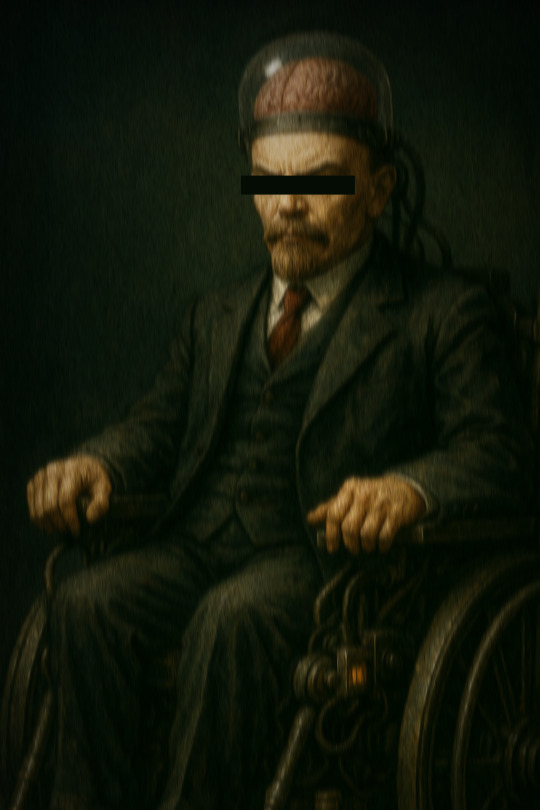
"This is fucking disgusting."
HIGH PATENT FILE – MOTHRA INSTITUTION
The Eleven Counselors — 0-1 | "Grandpa Lenin"
Name: Vladimir Ilyich Ulyanov
Position: Advisor 0-1 of the MOTHRA Eleven Counselors
Keycard Level: Omni Level
In ████, MOTHRA conducted Operation Daedalus, with the goal of recovering and reactivating the brain of Lenin,. The preserved body of Vladimir Lenin was secretly removed from his mausoleum in Moscow and brought to the MOTHRA Complex via Operation Notorious. Using advanced neurotechnology, MOTHRA scientists reactivated Lenin's brain through electromagnetic pulses and partial replacement of damaged tissue with synthetic neural matrices. The brain was reinserted into his preserved body, now fitted with a biomechanical life support system, with automated control and reinforced armor.
Upon awakening, Lenin was offered a position of influence inside MOTHRA Institution, and accepted it with a chilling smile. As the First Counselor of the Eleven, Lenin acts as the ideological advisor and strategic planner behind many of MOTHRA’s internal policies. Though reanimated, he retains 99% of his historical memories, alongside a sharpened political analysis engine embedded in his cortical net.
Lenin does not sleep. He spends most of his operational cycles reading, speaking to lower-level inmates about ideology, and offering cryptic counsel to the MOTHRA Directors. His "Mechanized Doctrine Speeches" are now distributed internally via encrypted institutional frequencies and analyzed for patterns of dissent or compliance among staff.
Biography: Born in Simbirsk, Russia, Vladimir Ilyich Ulyanovn, later known as Lenin, was a revolutionary theorist, political strategist, and the key architect of the Bolshevik Revolution. Following the fall of the Romanov dynasty, he established the Soviet Union and governed as its Premier until his official death in 1924. His ideologies laid the groundwork for Marxist-Leninist states worldwide and continue to echo in various revolutionary movements across the globe.
Known for his pivotal role in the Russian Revolution and subsequent establishment of the Soviet state. His life was characterized by revolutionary zeal, strategic maneuvering, and a staunch commitment to the principles of Marxism. After his death in January 1924, his body was preserved and placed on display in Moscow's Red Square, becoming a symbol of communist ideology.
Description: Maintained in a stasis-compatible cryo-embalming compound. The organic tissue, though visibly aged, is functionally augmented with biomechanical enhancements. These include an internal circulatory simulacrum, reinforced skeletal supports, and an exoskeletal spinal brace to sustain cranial interface operations.
Lenin is primarily wheelchair-bound, though not fully incapacitated. His custom-engineered wheelchair is equipped with multi-directional treads, electromagnetic stabilizers, and a shock-dampening seat frame designed for institutional navigation. Despite his limited ambulatory capacity, the wheelchair grants full-range movement and limited vertical ascension for elevated platforms or defensive posturing.
Lenin’s facial skin remains preserved, maintained through periodic dermal rehydration injections. His expressions carry a permanent semblance of stoic scrutiny. Optical implants allow for detailed retinal analysis of nearby individuals and environmental stimuli. His eyes, while retaining their historical blue-gray hue, display subtle red glints from the internal data-processing HUD overlays.
Speech is conducted via a vocal modulation apparatus embedded in his throat. The system reconstructs speech from neural impulses, emitting a low, mechanical tone that echoes through synthetic vocal cords. Though it mimics his original Russian inflection, the delivery lacks emotional cadence, resulting in an effect both unnerving and authoritative.
Lenin is never seen without his trusted weapon: a customized Winchester shotgun, dubbed "Red Dawn." The firearm is tactically modified, loaded with silver-cobalt shells and affixed to his wheelchair’s right armrest by a hydraulic auto-holster. The weapon is biometrically locked, but responds to Lenin’s vocal commands or neural trigger sequences, allowing immediate access in high-threat situations. Despite his apparent fragility, his reflexive command over the shotgun makes him lethally efficient in close-range confrontations.
Lenin's cognitive faculties have shown remarkable retention and adaptation to manipulate other technologies in contact. Extensive psychological evaluations indicate an ability to strategize and articulate complex political concepts. The integration of modern data processing capabilities enhances his comprehension of current events and historical contexts.
Final Notes: Recent evaluations indicate mixed results in terms of Lenin’s psychological adaptation. While he retains sharp memory, there are indications of frustration stemming from his pre-existing philosophies not aligning with modern socio-political landscapes. Observations have noted moments of reflective silence wherein he seems to grapple with the implications of his past decisions contrasted with present realities.
Regular psychological evaluations to monitor adaptation. Establish a mentoring program connecting him with burgeoning leaders to foster understanding and respect towards historical nuance.
7 notes
·
View notes
Text
How Does The Brain Work?
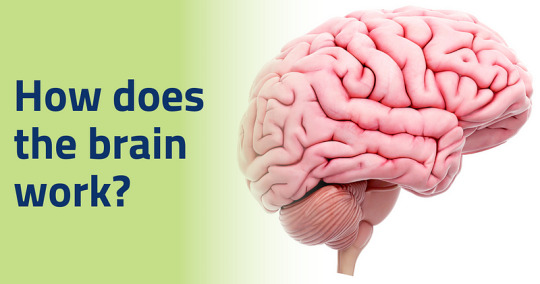
The brain stands as a marvel of biological engineering, Composing of a multitude of bodily functions ranging from cognition and memory to emotions and sensory perception. Together with the spinal cord, it constitutes the central nervous system (CNS), the command center of the human body.
Composition of the Brain
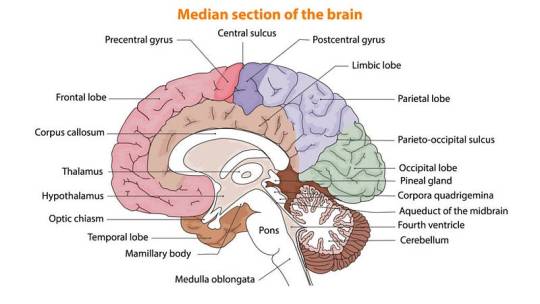
Weighing approximately 3 pounds in adults, the brain’s main structure comprises about 60% fat, interspersed with water, protein, carbohydrates, and salts. Unlike muscles, it houses a complex network of blood vessels and nerves, including neurons and glial cells.
a) Gray and White Matter
Within the central nervous system, gray matter and white matter occupies distinct regions. In the brain, gray matter forms the outer layer, rich in neuron somas, while white matter constitutes the inner section, primarily composed of axons unsheathed in myelin. Conversely, in the spinal cord, this arrangement is reversed.
b) Brain Functionality
The brain operates by transmitting and receiving chemical and electrical signals throughout the body. These signals regulate a myriad of processes, with the brain disseminating each input. Some signals remain confined within the brain, while others traverse the spinal cord and nerves, disseminating information across the body’s expanse. This composes neural network relies on billions of interconnected neurons.
Major Brain Regions and Their Functions
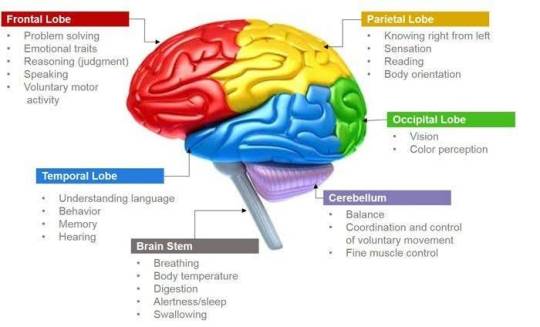
1.Cerebrum
Dominating the brain’s landscape, the cerebrum encompasses the cerebral cortex and underlying white matter. It governs a spectrum of functions, including motor coordination, temperature regulation, language processing, emotional regulation, and sensory perception.
2. Brainstem
Serving as the bridge between the cerebrum and spinal cord, the brainstem comprises the midbrain, pons, and medulla. It regulates vital autonomic functions such as heart rate, breathing, and reflexive responses.
3. Cerebellum
Nestled at the posterior aspect of the brain, the cerebellum coordinates voluntary muscle movements, posture, balance, and motor learning.
Brain Coverings
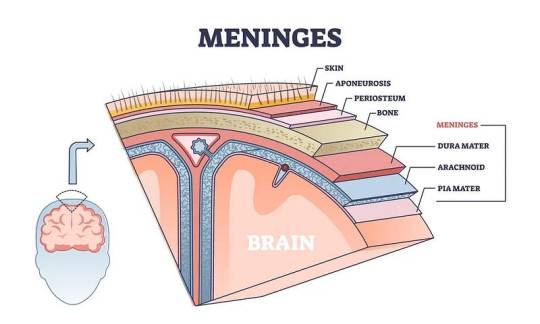
a) Meninges
Three layers of protective membranes, collectively known as meninges, enshroud the brain and spinal cord. These layers — dura mater, arachnoid mater, and pia mater — shield the delicate neural tissue from physical trauma and infection.
b) Lobes of the Brain
Each hemisphere of the brain comprises four lobes, each harboring distinct functional domains:
Frontal Lobe: Governing executive functions, motor control, and higher cognitive processes.
Parietal Lobe: Integrating sensory information, spatial awareness, and perception of pain and touch.
Occipital Lobe: Specialized for visual processing and perception.
Temporal Lobe: Involved in auditory processing, language comprehension, and memory consolidation.
Deeper Brain Structures
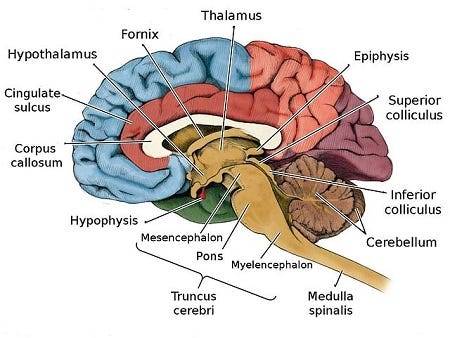
These encompass important structures such as the pituitary gland, hypothalamus, amygdala, hippocampus, and pineal gland, orchestrating hormone secretion, emotional regulation, memory consolidation, and circadian rhythms.
Blood Supply
The brain receives its oxygenated blood supply through the vertebral and carotid arteries, ensuring adequate perfusion of neural tissue. The main network of blood vessels, including the Circle of Willis, safeguards against ischemic insults and facilitates intraarterial communication.
Cranial Nerves
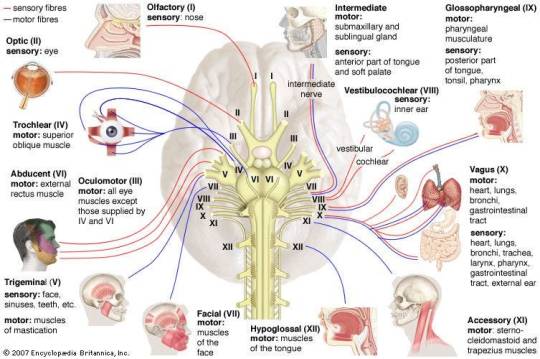
The twelve pairs of cranial nerves, originating from the brainstem, mediate a diverse array of sensory and motor functions, encompassing olfaction, vision, facial expression, and auditory perception.
Comprehending the anatomy and functionality of the brain fosters a deeper appreciation of its complexity and facilitates advances in neuroscientific research and therapeutic interventions aimed at diminishing neurological disorders.
Understanding the detailed anatomy and functionality of the brain is crucial for medical students embarking on their journey of study. Expert Academic Assignment Help offers invaluable assistance in navigating the complexities of neuroscience and related subjects. By leveraging expert guidance and support, students can excel in their medical education and contribute to advancements in the field of Medicine. Email us at [email protected] to embark on your path to scholarly excellence and professional competency.
#studying#studyblr#study blog#study aesthetic#student life#student#medical student#medical school#medicine#university student#university#university life#assignment help#medical students#nursing student#nursing school#healthcare#health and wellness#mental health#psychology#phd life#phd thesis writing service#online writing#do my online class#academic writing#essay writing#academic assignments#academia
17 notes
·
View notes
Text
magic system dr | economic impact of magic
------------------------------------------------------------------------------
date: june 25 2025. started: 10:01pm ended: 12:31
------------------------------------------------------------------------------





✧˖*°࿐economic impact of magic
magic isn’t just power; it’s capital. it's woven into every fabric of modern society, shaping who earns more, who gets access, and who’s left behind.
in a world where 50% of the population possesses aura-based abilities, economies have evolved to deeply entangle magic into industrial growth, labor markets, and innovation pipelines. this comes with massive boosts in productivity, but also widening gaps between the empowered and the ordinary.
✧˖*°࿐magic professions
the magical labor class is divided into tiers based on their integration and reliance on innate magical skill.
*ೃ༄pure magic professions
“The elite core—their power is their career.”
hobs in this category require magical ability as a baseline—non-magic users cannot perform them at all. these careers are exclusive, highly trained, and often government-certified.
დ࿐ ˗ˋ examples include: ꪆৎ 𓂃 › healers: use light or water-aligned auras to mend tissue, purge illness, and stabilize mana flux. employed in hospitals, war zones, elite clinics. ꪆৎ 𓂃 › weather controllers: employed by governments and agritech firms to regulate rainfall, prevent hurricanes, or stabilize climate in ley-sensitive regions. ꪆৎ 𓂃 › industrial shapers: manipulate raw materials (metal, stone, glass, etc.) using earth/fire magic in advanced manufacturing or high-speed infrastructure work.
დ࿐ ˗ˋ economic profile: ꪆৎ 𓂃 › average salary: 150–300% of a non-magical equivalent ꪆৎ 𓂃 › benefits: housing subsidies, mana therapy, elite union protection ꪆৎ 𓂃 › education: specialized magical academies or apprenticeships
𓂃 ࣪˖ ִֶָꪆৎ barriers to entry: power class minimum (often C4 or higher), licensing, tone compatibility (e.g., metalwork requires metallic or earth affinity)
*ೃ༄magic-enhanced professions
“Same job. Better tools. Better you.”
these are ordinary professions where magic augments efficiency, creativity, or safety. magic here isn't required, but it gives a powerful edge.
დ࿐ ˗ˋ examples include:
ꪆৎ 𓂃 › chefs who use fire or air manipulation to control flavor profiles, or speed-cook with zero nutrient loss. ꪆৎ 𓂃 › teachers who use aura projectors to simulate historical scenes or model physics in real time. ꪆৎ 𓂃 › construction workers with strength-enhancement enchantments, levitation rigs, or mana-powered tools that outperform standard tech.
დ࿐ ˗ˋ economic profile:
ꪆৎ 𓂃 › average salary: 120–180% of the non-magical version of the same job ꪆৎ 𓂃 › hiring trends: many employers actively prefer low-power users with skilled control (B5, C6), especially in manual industries ꪆৎ 𓂃 › workplace culture: often have mixed teams; some unions demand hazard bonuses for aura-related risk
*ೃ༄magic-adjacent professions
“You might not wield it—but you’re helping shape it.”
these jobs do not require magic, but support and sustain the magical economy. they’re the backbone of innovation, regulation, and development.
დ࿐ ˗ˋ examples include: ꪆৎ 𓂃 › focus crafters: engineers and artisans who create wands, rings, tattoos, or neural-channeling implants to help mages focus and direct power. ꪆৎ 𓂃 › magical researchers: scientists who study aura development, crystal stability, tone-mutation disorders, leyfield dynamics. ꪆৎ 𓂃 › trainers and coaches: former mages or theory experts who prepare children and adults to harness magic responsibly and efficiently.
დ࿐ ˗ˋ economic profile: ꪆৎ 𓂃 › average salary: 110–150% of comparable non-magical roles ꪆৎ 𓂃 › demand: extremely high in academies, tech companies, and military organizations ꪆৎ 𓂃 › opportunities for non-mages: high—many elite researchers and trainers are non-magical with strong scientific backgrounds





✧˖*°࿐economic disparity
magic shapes not just the market, but who succeeds within it—and who gets left behind.
*ೃ༄magical premium
“Aura pays.”
𓂃 ࣪˖ ִֶָꪆৎ across the board, magic users make more money than non-magic individuals, regardless of education or field.
𓂃 ࣪˖ ִֶָꪆৎ this premium starts young: magical teens are recruited into elite academies or training programs, often with full sponsorship, leaving non-magic peers behind.
𓂃 ࣪˖ ִֶָꪆৎ upward mobility is statistically much higher for magic users, especially those with rare tones or high-class power ratings.
𓂃 ࣪˖ ִֶָꪆৎ some countries have begun taxing magic-enhanced income separately or offering compensatory subsidies to non-magical citizens to prevent civil unrest.
*ೃ༄non-magical movements
“Equal worth, not equal power.”
𓂃 ࣪˖ ִֶָꪆৎ civil rights movements, sometimes called the equal line, have emerged in many countries to advocate for non-magical inclusion and parity.
დ࿐ ˗ˋ issues include:
ꪆৎ 𓂃 › access to top-tier education ꪆৎ 𓂃 › bias in hiring processes ꪆৎ 𓂃 › discriminatory housing loans or land zoning (aura-only neighborhoods) ꪆৎ 𓂃 › legal disadvantages in court if facing a magic-using party
𓂃 ࣪˖ ִֶָꪆৎ some factions go militant, blaming mages for economic stagnation, cultural elitism, or leyline overuse. these groups are often monitored by authorities.
*ೃ༄innovation gaps
“Why invent something new, when magic can fix it now?”
დ࿐ ˗ˋ societies heavily reliant on magic see slowed technological advancement, particularly in: ꪆৎ 𓂃 › renewable energy (replaced by mana stones) ꪆৎ 𓂃 › robotics and automation (less needed with spell labor) ꪆৎ 𓂃 › cybernetics (replaced by magical implants or bodily enhancement)
დ࿐ ˗ˋ this leads to: ꪆৎ 𓂃 › stagnation in non-magical research sectors ꪆৎ 𓂃 › global inequality between tech-heavy vs. magic-heavy regions ꪆৎ 𓂃 › long-term vulnerability if leyline networks collapse or mana becomes corrupted
𓂃 ࣪˖ ִֶָꪆৎ some corporations are hybridizing magic and tech, but face fierce resistance from old-guard magical guilds who prefer aura-dominant systems.





✧˖*°࿐societal observations
𓂃 ࣪˖ ִֶָꪆৎ dating markets and matchmaking often include aura class or color compatibility—creating magical aristocracies and social hierarchies.
𓂃 ࣪˖ ִֶָꪆৎ "aura insurance" exists for workplaces: covers liability if someone’s aura injures, sabotages, or causes damage—even if unintentional.
𓂃 ࣪˖ ִֶָꪆৎ regions with low magic populations often become tech hubs by necessity, creating a different kind of elite in engineering, cybersecurity, or biotech.
𓂃 ࣪˖ ִֶָꪆৎ some governments now offer “Magic Literacy Grants” to help non-mages become competent in understanding magical theory, for employment inclusion.
#reyaint#reality shifting#shiftblr#reality shifter#shifting#shifting community#shifting motivation#anti shifters dni#dr scrapbook#dr world#boarding school dr#magic system dr
4 notes
·
View notes
Text
Human augmentation:
refers to the use of technology to enhance physical, cognitive, or sensory abilities beyond natural human limits. Augmentation can be temporary or permanent and can range from simple tools to advanced cybernetic implants. Here are some key ways a person can be augmented:
### **1. Physical Augmentation**
- **Prosthetics & Exoskeletons**: Advanced prosthetic limbs (bionic arms/legs) and powered exoskeletons can restore or enhance mobility and strength.
- **Muscle & Bone Enhancements**: Synthetic tendons, reinforced bones, or muscle stimulators can improve physical performance.
- **Wearable Tech**: Smart clothing, haptic feedback suits, and strength-assist devices can enhance endurance and dexterity.
### **2. Sensory Augmentation**
- **Enhanced Vision**: Bionic eyes (retinal implants), night-vision contact lenses, or AR/VR headsets can extend visual capabilities.
- **Enhanced Hearing**: Cochlear implants or ultrasonic hearing devices can improve or restore hearing.
- **Tactile & Haptic Feedback**: Sensors that provide enhanced touch or vibration feedback for better interaction with machines or virtual environments.
- **Olfactory & Taste Augmentation**: Experimental tech could enhance or modify smell/taste perception.
### **3. Cognitive Augmentation**
- **Brain-Computer Interfaces (BCIs)**: Neural implants (e.g., Neuralink, neuroprosthetics) can improve memory, learning speed, or direct brain-to-machine communication.
- **Nootropics & Smart Drugs**: Chemical enhancements that boost focus, memory, or mental processing.
- **AI Assistants**: Wearable or implantable AI that aids decision-making or information retrieval.
### **4. Genetic & Biological Augmentation**
- **Gene Editing (CRISPR)**: Modifying DNA to enhance physical traits, disease resistance, or longevity.
- **Synthetic Biology**: Engineered tissues, organs, or blood substitutes for improved performance.
- **Biohacking**: DIY biology experiments, such as implanting magnets in fingers for sensing electromagnetic fields.
### **5. Cybernetic & Digital Augmentation**
- **Embedded Chips (RFID, NFC)**: Subdermal implants for digital identity, keyless access, or data storage.
- **Digital Twins & Cloud Integration**: Real-time health monitoring via embedded sensors linked to cloud AI.
- **Neural Lace**: A mesh-like brain implant for seamless human-AI interaction (still experimental).
### **6. Performance-Enhancing Substances**
- **Stem Cell Therapies**: For faster healing and regeneration.
- **Synthetic Hormones**: To boost strength, endurance, or recovery.
- **Nanotechnology**: Microscopic machines for repairing cells or enhancing biological functions.
### **Ethical & Social Considerations**
- **Privacy & Security**: Risks of hacking or surveillance with embedded tech.
- **Inequality**: Augmentation could widen gaps between enhanced and non-enhanced individuals.
- **Identity & Humanity**: Philosophical debates on what it means to be "human" after augmentation.
### **Current & Future Trends**
- **Military & Defense**: DARPA and other agencies are working on super-soldier programs.
- **Medical Rehabilitation**: Restoring lost functions for disabled individuals.
- **Transhumanism**: A movement advocating for human enhancement to transcend biological limits.
Would you like details on a specific type of augmentation?
#future#cyberpunk aesthetic#futuristic#futuristic city#cyberpunk artist#cyberpunk city#cyberpunkart#concept artist#digital art#digital artist#human augmentation#augmented human#human with a robot brain#futuristic theory#augmented brain#augmented reality#augmented
3 notes
·
View notes
Text
North Mural, and the V.H.Z. era
The timeline of Goodbye Strangers isn't strictly linear (or, rather; it's multi-dimensional), which is why the VHZ era has numerous "entry points". So, something I don't think I've mentioned is that within the world of North Mural, Default and Bracey don't escape the Red Hell Engine, and are killed by Argona and Olivia. Default is heavily experimented on by Olivia before his brain is removed (and experimented upon further), and Bracey becomes Argona's general test subject. (It's weird and a little scary to think about this, haha.)
This major jump in technology marks North Mural's entry point to the VHZ era – Default's neural tissue becomes the basis for the kaleido-rooms and other kaleido-technology, for example, whereas Argona's experiments lead to major advancements in stranger extrusion. And, this sort of 'entanglement' (with these diverging alternate pasts) is also why the V.H.Z. era is fundamentally unstable… linking it to the meta-level/cross-dimensional catastrophe of the Flood.
10 notes
·
View notes
Text

DARPA Brain Technologies: Electrical Prescriptions (ElectRx) This is some pretty old tech source. Wonder what kind of psychedelics though? The ElectRx program aims to help the human body heal itself through neuromodulation of organ functions using ultraminiaturized devices, approximately the size of individual nerve fibers, which could be delivered through minimally invasive injection.
Neural Engineering System Design (NESD) Looks like they're beating Elon to the punch here. The NESD program aims to develop an implantable neural interface able to provide unprecedented signal resolution and data-transfer bandwidth between the brain and the digital world.
Next-Generation Nonsurgical Neurotechnology (N3) The N3 program aims to develop a safe, portable neural interface system capable of reading from and writing to multiple points in the brain at once. Whereas the most advanced existing neurotechnology requires surgical implantation of electrodes, N3 is pursuing high-resolution technology that works without the requirement for surgery so that it can be used by able-bodied people.
Six Paths to the Nonsurgical Future of Brain-Machine Interfaces
Nonsurgical Neural Interfaces Could Significantly Expand Use of Neurotechnology Targeted Neuroplasticity Training (TNT) Matrix Shit The TNT program seeks to advance the pace and effectiveness of cognitive skills training through the precise activation of peripheral nerves that can in turn promote and strengthen neuronal connections in the brain. TNT will pursue development of a platform technology to enhance learning of a wide range of cognitive skills, with a goal of reducing the cost and duration of the Defense Department’s extensive training regimen, while improving outcomes.
Neuro Function, Activity, Structure and Technology (Neuro-FAST) The Neuro-FAST program seeks to enable unprecedented visualization and decoding of brain activity to better characterize and mitigate threats to the human brain, as well as facilitate development of brain-in-the loop systems to accelerate and improve functional behaviors. The program has developed CLARITY, a revolutionary tissue-preservation method, and builds off recent discoveries in genetics, optical recordings and brain-computer interfaces. Restoring Active Memory (RAM) The RAM program aims to develop and test a wireless, fully implantable neural-interface medical device for human clinical use. The device would facilitate the formation of new memories and retrieval of existing ones in individuals who have lost these capacities as a result of traumatic brain injury or neurological disease.
18 notes
·
View notes
Text
scrapping Violet’s (mad scientist’s) design for now because I can’t draw her as creepy as I want… but the concept is still here.
Here’s some random lore because I’m hyped for her:
Violet’s eyes are one of her more notable features (besides her stitches / staples), but one is a glass eye and the other is completely milky white. She doesn’t see the BEST out of her white eye, but it’s the one she has. The glass eye resulted from an accident that she just shrugs off. Everyone makes mistakes and has to learn, right?
More appearance notes: she is very unsettling… like uncanny valley shit.
She is super into ethics, despite her self-experimentation. Thats why she does it, actually. To prevent harm to others or animals. She has her own twisted sense of ethics.
Because of her extensive experimentation, her nerves are kinda shot. She doesn’t really feel too much sensation anymore on various parts of her skin. She also oddly seems to be extremely tolerant of pain and doesn’t really use painkillers or anesthesia. She has shocked herself back to life several times and will do it several more.
Violet has actually made some helpful medical contributions! She’s just… not very accepted in person or practice, but hey! She’s done something! She’s helped!
Previously, she worked as a mortician, but went back to school to get her doctorate. She’s technically a biomedical engineer. She does stuff like create tissues that can be grown into organs and skin, etc. She does a lot of stuff regarding organ transplants and stuff. She’s also researched and done things with neural engineering, which regards the brain and repairing, replacing, enhancing it, etc. You can see where this is going…
9 notes
·
View notes